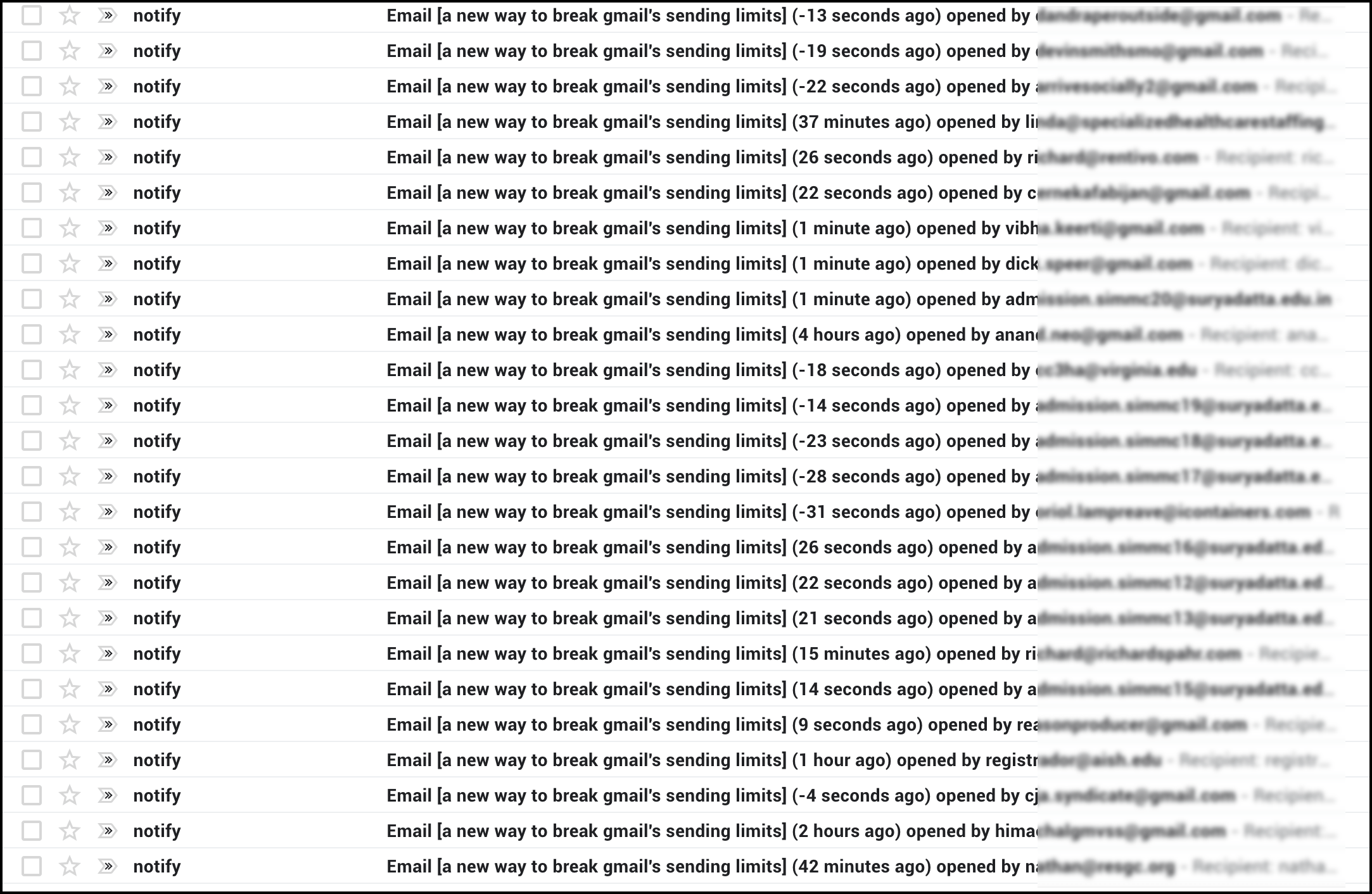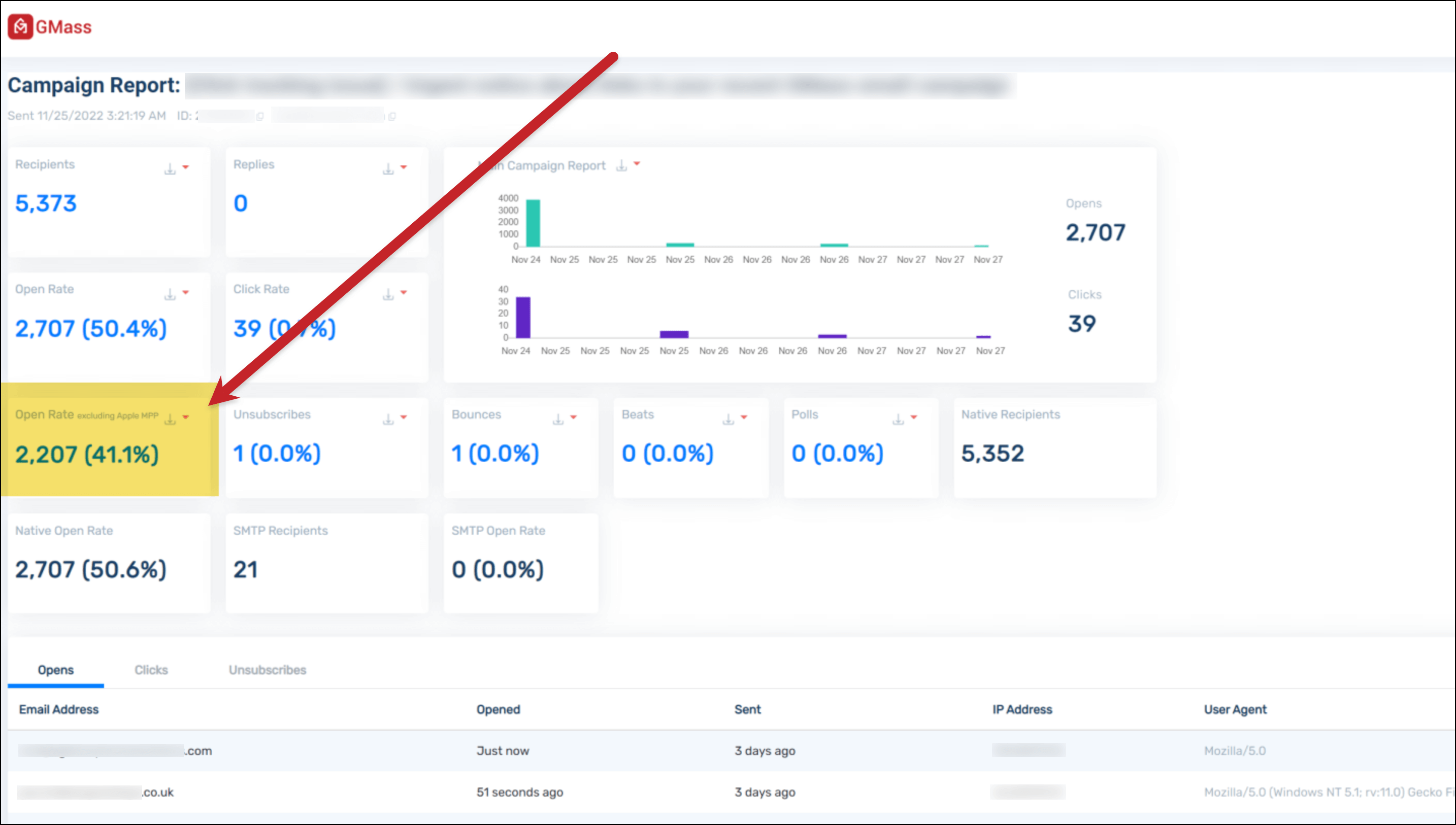
False opens are an endless source of frustration for any analytics-minded emailer.
Which is why here at GMass, we’re eternally committed to detecting them and keeping them from skewing your numbers.
This blog post is our log of ways we’ve dealt with the false opens problem for Gmail users.
False Opens: Table of Contents
- Why False Opens Are a Problem
- Detecting and Filtering the First Wave of False Bot Opens (May 2019)
- Apple Mail Privacy Protection (November 2022)
- More Sophisticated Open Bot Detection (November 2024)
- Getting Started with GMass
Why False Opens Are a Problem
Whenever a conversation on Reddit or any other email group turns to open rates, there’s invariably someone who’ll say: “Who cares about open rates?”
They aren’t totally off-base. After all, with most emails, the endgame isn’t opens — it’s replies or clicks.
But to that, we say: People can’t reply to or click on your email if they don’t open it. The more people who open it, the more who will have the chance to reply or click.
And the more accurately you know your open rates, the better you can assess what’s working with your subject lines, preview text, and inbox presence.
That’s why false opens are a problem.
When your open rates are inflated or inaccurate, it throws off…
- Your ability to gauge a campaign’s effectiveness.
- A/B tests.
- Your understanding of how engaged your email list actually is.
- Your triggered emails, sending to people when you know they’re in their inbox.
- And your credibility. If you’re working with clients or sharing campaign reports online, it’s a bad look when you present an obviously inflated open rate.
Which is why we at GMass are among the most aggressive email sending platforms (if not the most aggressive) in detecting and filtering false opens.
Here’s the history of our battle with false opens.
Detecting and Filtering the First Wave of False Bot Opens (May 2019)
We recently noticed inflated open rates across campaigns, and upon a detailed examination, we found that Gmail has been triggering false opens on emails since May of 2018.
Specifically, Gmail has been triggering opens via a bot as soon as an email is received by a Gmail user, and Gmail triggers the open from one of many Google IP addresses with this specific User Agent:
Mozilla/5.0 (Windows NT 10.0; Win64; x64) AppleWebKit/537.36 (KHTML, like Gecko) Chrome/42.0.2311.135 Safari/537.36 Edge/12.246 Mozilla/5.0
By analyzing all the IP addresses that downloaded our open tracking pixel with this specific User Agent, we are confident that all the opens from this User Agent are false opens.
Additionally, opens from this User Agent happen within seconds after sending an email. We recently added a time designation to the “open” notifications that GMass users receive in the GMass Reports –> Opens Label. The Subject line of the notification shows how much time has elapsed between the email sending and the email opening. All of the “false” opens are recorded in mere seconds after the email is sent:

In GMass’s lifetime, as of today, approximately 307 million total email opens have been recorded across all campaigns across all users. Today’s analysis shows that this User Agent first started appearing in our open tracking logs in May of 2018 at a fairly infrequent rate of about 500,000 incidences per 20 million recorded opens, or a false open rate of 2.5%. This steadily increased over time to an incidence rate of 1.3 million per the 20 million most recently recorded opens, or a false open rate of 6.5%. That means that at most your open rates on past campaigns may go down by 6.5%, but likely less than 6.5%.
How good are you at percentage math? Assuming your open rate goes down by 5%, this does NOT mean that a campaign that previously had a 20% open rate will now have a 15% open rate. It means that a campaign that previously had a 20% open rate will now have a 19% open rate (19% is 5% less than 20%).
The Google Image Proxy
Several years ago, Google introduced the Google Image Proxy, which is a system by which images are downloaded in Gmail not from the source server, but via a proxy operated by Google. The whole concept of “open tracking” in email campaigns relies on a unique one-pixel image being downloaded.
The purpose of inserting the proxy between the end recipient and the email marketing service’s server was to obfuscate the location of the download, preventing companies like GMass and MailChimp from knowing the details of the “open”, such as the location and device used to open the email. The proxy still allowed ESPs to know IF an email was opened, however.
This new behavior is a separate issue from the Google Image Proxy, and Litmus has also found this to be the case.
The Google Image proxy uses a variety of User Agents, such as:
Mozilla/5.0 (Windows NT 5.1; rv:11.0) Gecko Firefox/11.0 (via ggpht.com GoogleImageProxy)
but always includes this bit:
(via ggpht.com GoogleImageProxy)
An open triggered by the Google Image Proxy does seem to be a real human opening an email, however an open triggered by the previously mentioned User Agent seems to be an open triggered by a Google bot.
The irony is therefore, that the User Agent that looks like a bot is actually a human, while the User Agent that looks like a human is actually the bot.
We have deleted millions of opens
In order to accurately convey open statistics to our users, we have deleted the approximately 4.5 million false open records from our system, and updated campaign reports will reflect this. If you notice your open rates drop on a campaign, it’s because we have deleted these false opens.
Going forward, we won’t count these as real opens
As of today, opens that originate from this User Agent will be ignored by GMass and not counted in your campaign reports.
Why did it take so long for us to notice?
First, wishful thinking. You see high open rates, and you want to believe it’s true. Why investigate something that’s making you look like an email marketing rockstar?
Secondly, the User Agent looks like a regular, normal User Agent. It looks like a real browser being used by a real human. Shame on Google for doing this in such a sneaky way.
Thirdly, it seems that not many other email marketing services have noticed either. We belong to a number of email marketing industry associations and discussion groups, and this issue hasn’t been mentioned at all. In fact, the only other mention of this issue I could find was in this Litmus discussion.
Other sources of false opens
Unfortunately, the mysterious Google bot isn’t the only source of false opens. It’s possible for you, the user to trigger a false open on behalf of your recipient as well, as we explain in this post on why your open tracking stats may be inaccurate.
The good news is that we now have a solution to this problem — such that if you open an email from your Sent Mail, or you open a bounce notification, an “open” will not be triggered.
Unrelated, but interesting SEO find
I’ve reported before how Google doesn’t rank its own content over others. This is the case with the Google Image Proxy. If you Google “Google Image Proxy”, you’ll see articles from x, y, and z, but the official Google announcement on the introduction of the proxy is all the way on page X! Go figure!
Apple Mail Privacy Protection (November 2022)
A few years back, Apple began pre-loading every email sent to anyone using the Mail app.
And after Apple Mail Privacy Protection went into effect, GMass became the first cold email platform to show open rates with and without Apple’s false opens.
That said, our data found Apple’s MPP did not have a massive effect on open rates — not at all.
Still, we continue to break out opens with and without Apple MPP opens in your reporting so you can see the difference yourself.
More Sophisticated Open Bot Detection (November 2024)
We’ve just made significant improvements to our algorithm to separate legitimate opens from bot opens.
We developed this algorithm using Claude. I’m even giving it away — so if you’re interested, here’s the code. (It’s in C# and the main function is “isValidEmailOpen”.)
Here’s how it works:
- We’ve compiled a comprehensive list of known bot agents, representing the automated systems that falsely “open” emails.
- We’ve compiled lists of unusual browser combinations that can appear in the reported userAgent — which are also connected to bots. Based on our research, we’ve found when a userAgent is impersonating multiple browsers (e.g., Chrome and Safari and Edge), it’s a bot. For instance,
Mozilla/5.0 (Windows NT 10.0; Win64; x64) Apple WebKit/537.36 (KHTML, like Gecko) Chrome/42.0.2311.135 Safari/537.36 Edge 12.246 Mozilla/5.0is a bot every time. - We also have lists of the valid email image proxies and common browser identifiers — both of which are correlated with legitimate opens.
Now, on every triggered open, we check the userAgent to see if it matches the bot signifiers (known bot agents, unusual browser combos) — and if so, we flag that open as invalid.
But if the open matches the known browsers or image proxies — or the userAgent is empty — those are all signifiers of real opens.
This means some people’s open rates will go down
While we can’t retroactively go back to change previous open reports, all reports going forward from GMass will use our new, more sophisticated bot detection.
And yes, that means some people will see lower open rates than they’re used to.
However, we’re confident these new open rates are also the most accurate ones they’ll see. (And, I’ll note, far more accurate than the open rates you’ll see in the screenshots people post from other email platforms.)
Getting Started with GMass
Sophisticated false open detection and filtering is just one of the many, many things we’re doing different and better here at GMass.
Come see why 300,000+ people use GMass and give us an average of 4.8/5 stars across 10,000+ reviews.
From our unlimited everything (emails, contacts, and more) to our unique suite of deliverability tools like Spam Solver, GMass is a better email platform than you’re used to.
You can get started by downloading the Chrome extension. It’s free to try — no credit card required — and you’ll be able to send your first campaign in a matter of minutes.
Plus, you now know that first campaign will have the most accurate open rates you’ll ever see.
Email marketing, cold email, and mail merge all in one tool — that works inside Gmail
TRY GMASS FOR FREE
Download Chrome extension - 30 second install!
No credit card required












Hi Ajay,
So we had a problem…but your recovery was GREAT!
Nice observation. Great work. Kudos
Hi Ajay,
I’m seeing multiple opens by the same user over the course of a couple minutes and then again even later.
That issue aside, I’m concerned that false positives won’t get the appropriate follow up messages. Is that a valid concern?
Hi Ajay,
Thanks for the info! I am seeing an unexpected # of open-rates with 1 particular recipient domain(in the 90s). Could something within their Microsoft Outlook email server configuration be triggering an open for the Gmass tracking?
Hi Chris,
Yes, whenever the tracking pixel is downloaded it will trigger an open instance. Sometimes one recipient generates a large number of opens because their email software does something wacky.
The best source of data is the campaign-level report under GMass Reports –> CAMPAIGNS.
When downloading the Campaign report, can you tell me what the number of opens means (it is specifically displayed as NumberOfOpens). Is that the number of opens for all campaigns for that email recipient, or the number of opens for that specific campaign? Why would the number be greater than one? Thanks.
Hi!,
In my company we have seen a huge increase in opens, in only one type of emails the past two weeks, and we have seen the last month some strange results about the opens in gmail, do you have seen this with your clients this weeks?
Thank you
Hi,
If we check the sent mail it shows “open” how to find who opened the mail?
Even if we open it shows open and if a customer opens it shows open !!!
Nice Article. Confirmed my findings too.